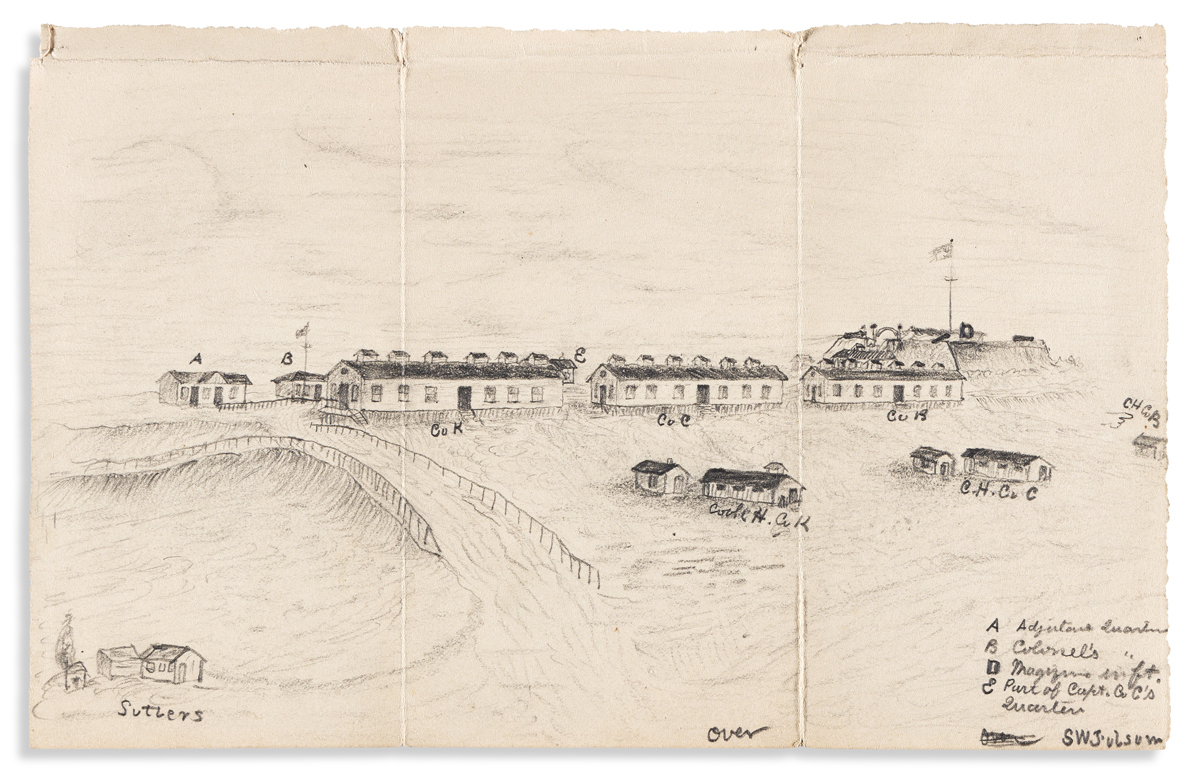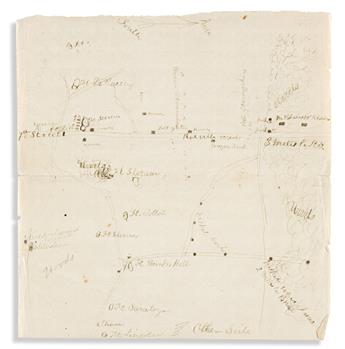Sale 2564 - Lot 192
Price Realized: $ 1,600
Price Realized: $ 2,080
?Final Price Realized includes Buyer’s Premium added to Hammer Price
Estimate: $ 1,500 - $ 2,500
(CIVIL WAR--OHIO.) Archive of diaries, plans, sketches, and correspondence of an articulate young Cleveland soldier. 79 items housed in 2 binders (0.3 linear feet): 3 complete yearly manuscript diaries from 1864-1866, each 6 1/2 x 3 inches with three entries per page plus memoranda; 5 manuscript sketches and plans from his service in Washington; a 150th Ohio regimental ribbon, 6 3/4 x 2 1/4 inches; a certificate of membership in his militia unit; and 69 letters addressed to the soldier, many accompanied by the original stamped and postmarked envelopes. Condition generally very strong. Vp, 1861-66
Additional Details
Samuel Whitfield Folsom (1844-1929) was born and raised in Cleveland, OH , son of a prosperous early settler. When the war broke out, he was just starting a long career as an accountant, and joined an Ohio National Guard unit. As his diary begins in January 1864, he attends a variety of cultural events in Cleveland. On 21 February he writes: "Heard Frederick Douglas deliver a lecture on the ‘Mishions of the War.' I enjoyed it very much. Douglas displays very fine powers of oratory and has a head that looks as though it might contain a great deal of knowledge." On 26 April, he began a new position in Meadville, PA as private secretary to the president of the Atlantic & Great Western Railroad. 4 days later, he wrote: "Received an order . . . to report at the Armory, Cleveland, 10 o'clock A.M., the National Guards (to which I belong) having been called out for 100 days. I telegraphed home to inquire if Father had procured a substitute for me. Rec'd an ans., ‘No.'"
Folsom's diary of his experience as a private in the 150th Ohio Infantry is well-written and legible, with a full entry for each day. His company spent the entire period in the defenses of Washington, mostly shuttling back and forth between Forts Stevens and Bunker Hill. He spent 7 June on picket duty on the property of Lincoln's cabinet member Montgomery Blair: "Have been furnished with all the milk we could drink from Postmaster Blair." On 14 June he wrote : "Attended a picnic by colored people held in a grove nearby. They had dancing, with pretty good music. Had a good opertunity of judging the character of these people. I took strawberries at their tables for refreshments."
His closest brush with combat was the Battle of Fort Stevens, part of which he was able to observe from nearby Fort Bunker Hill: "This morning heard very heavy firing of musketry & cannon. Think Rebels have made a charge on Ft. Stevens. Was relieved from picket 8 a.m., found a good deal of excitement among the boys at the fort. They have slept side of the cannons for two nights. There has been pretty hard fighting at Fort Stevens all day. . . . Rebels left Fort Stevens last night. We saw most of the fighting yesterday from our fort. Expected the Rebs would attack this fort last night. . . . Saw a cloud of dust north of here & I went with 6 others & Lieut. on a scouting expedition, found it to be a large force of Rebs on the retreat" (12-13 July). Over the next week, Folsom made two visits to the battleground to hunt for relics, noting that he "saw the several graves of the Rebels, one containing 17, one 37, another 2, & several single graves" (17 July).
Folsom soon mustered out, but his diaries continue through the end of 1866. He describes the scene in Meadville on the eve of Election Day in 1864: "Democratic meeting here today. The Union party played a good joke on the McClellanites. Last night they made a battery in the square & placed a Quaker gun pointing towards the square. Upon the battery was written Manassas. I never saw so many intoxicated here before today" (2 November). Additional notes on his diaries are available upon request.
Folsom was a good amateur draftsman, and sent home 5 pieces from his wartime service: a detailed drawing of a highway turnpike gatehouse in Washington where he did picket duty, described in his diary on 17 June 1864; a view of the barracks at Fort Bunker Hill (noted in his diary on 8 July 1864); detailed plans of Forts Bunker Hill and Stevens; and finally a map of the Battle of Fort Stevens, some of which he had witnessed. It shows the location of the Union and Rebel skirmishers north of the fort, the other forts comprising the northern defenses of Washington, the home of Montgomery Blair where he had previously been on picket duty, and the location where Folsom was on picket not far from the start of the fighting.
Finally, the collection includes 69 letters addressed to Folsom during the war years by friends and family members, most of them in Cleveland. Two are on patriotic letterhead. Many of the letters are from his sister Hadassah, a Cleveland educator who wrote regularly during his months at the front.
Folsom's diary of his experience as a private in the 150th Ohio Infantry is well-written and legible, with a full entry for each day. His company spent the entire period in the defenses of Washington, mostly shuttling back and forth between Forts Stevens and Bunker Hill. He spent 7 June on picket duty on the property of Lincoln's cabinet member Montgomery Blair: "Have been furnished with all the milk we could drink from Postmaster Blair." On 14 June he wrote : "Attended a picnic by colored people held in a grove nearby. They had dancing, with pretty good music. Had a good opertunity of judging the character of these people. I took strawberries at their tables for refreshments."
His closest brush with combat was the Battle of Fort Stevens, part of which he was able to observe from nearby Fort Bunker Hill: "This morning heard very heavy firing of musketry & cannon. Think Rebels have made a charge on Ft. Stevens. Was relieved from picket 8 a.m., found a good deal of excitement among the boys at the fort. They have slept side of the cannons for two nights. There has been pretty hard fighting at Fort Stevens all day. . . . Rebels left Fort Stevens last night. We saw most of the fighting yesterday from our fort. Expected the Rebs would attack this fort last night. . . . Saw a cloud of dust north of here & I went with 6 others & Lieut. on a scouting expedition, found it to be a large force of Rebs on the retreat" (12-13 July). Over the next week, Folsom made two visits to the battleground to hunt for relics, noting that he "saw the several graves of the Rebels, one containing 17, one 37, another 2, & several single graves" (17 July).
Folsom soon mustered out, but his diaries continue through the end of 1866. He describes the scene in Meadville on the eve of Election Day in 1864: "Democratic meeting here today. The Union party played a good joke on the McClellanites. Last night they made a battery in the square & placed a Quaker gun pointing towards the square. Upon the battery was written Manassas. I never saw so many intoxicated here before today" (2 November). Additional notes on his diaries are available upon request.
Folsom was a good amateur draftsman, and sent home 5 pieces from his wartime service: a detailed drawing of a highway turnpike gatehouse in Washington where he did picket duty, described in his diary on 17 June 1864; a view of the barracks at Fort Bunker Hill (noted in his diary on 8 July 1864); detailed plans of Forts Bunker Hill and Stevens; and finally a map of the Battle of Fort Stevens, some of which he had witnessed. It shows the location of the Union and Rebel skirmishers north of the fort, the other forts comprising the northern defenses of Washington, the home of Montgomery Blair where he had previously been on picket duty, and the location where Folsom was on picket not far from the start of the fighting.
Finally, the collection includes 69 letters addressed to Folsom during the war years by friends and family members, most of them in Cleveland. Two are on patriotic letterhead. Many of the letters are from his sister Hadassah, a Cleveland educator who wrote regularly during his months at the front.
Exhibition Hours
Exhibition Hours
Aliquam vulputate ornare congue. Vestibulum maximus, libero in placerat faucibus, risus nisl molestie massa, ut maximus metus lectus vel lorem.






